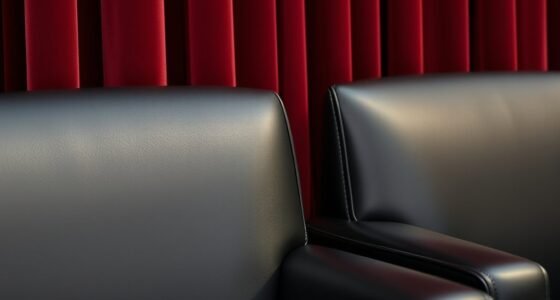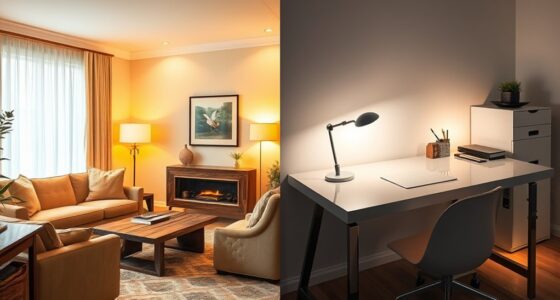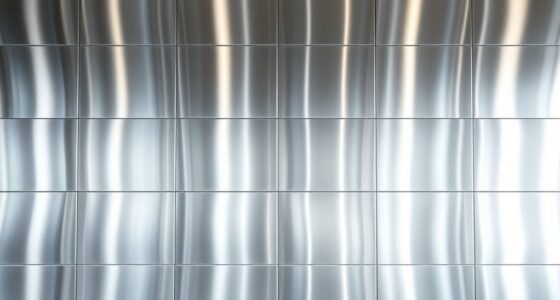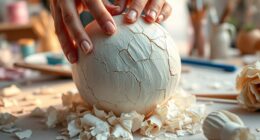Micro textures like ribbed glass and fluted wood add visual depth and tactile interest to surfaces, enhancing your interaction with them. Ribbed glass features ridges that diffuse light and provide a textured feel, making it ideal for privacy and decorative panels. Fluted wood, with its grooves and channels, offers a better grip and a sophisticated look. Exploring these surface details can transform everyday materials into functional and stylish design elements—you’ll discover more about their impact as you continue.
Key Takeaways
- Micro textures like ribbed glass and fluted wood feature tiny surface patterns that influence visual, tactile, and functional properties.
- Ribbed glass’s ridges diffuse light and provide tactile grip, enhancing privacy and decorative appeal.
- Fluted wood’s grooves add depth, improve grip, and create visual sophistication in furniture and architectural details.
- Both textures elevate materials from simple surfaces to sophisticated design elements with added character.
- These micro textures impact perception, engagement, and usability by modifying light reflection, tactile feel, and functional performance.
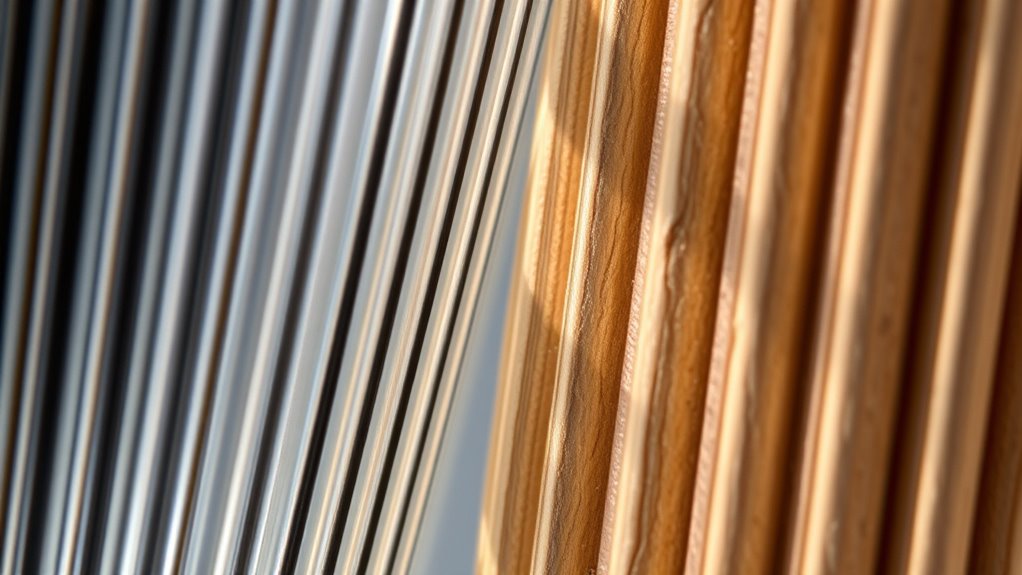
Micro textures are tiny surface features that play a crucial role in determining how materials interact with their environment. When you look closely at materials like glass and wood, you’ll notice these subtle details—surface patterns and tactile finishes—that greatly influence both their appearance and feel. These micro textures can transform a simple material into a sophisticated design element, adding depth, character, and functionality.
Micro textures subtly enhance materials’ appearance, feel, and interaction, transforming simple surfaces into sophisticated design elements.
Take ribbed glass, for example. Its surface pattern features evenly spaced ridges running vertically or horizontally across the surface. These tiny textures aren’t just decorative; they create a tactile finish that affects how you perceive and interact with the material. When you run your fingers over ribbed glass, you’ll feel the ridges that provide a textured sensation, making the surface more interesting and less slippery compared to smooth glass. The tactile finish also diffuses light, reducing glare and creating a softer, more inviting appearance. This combination of visual and tactile qualities makes ribbed glass ideal for privacy screens or decorative panels, where both aesthetics and functionality matter. The surface patterns in ribbed glass can be subtle or pronounced, depending on the desired effect, giving you options to customize the look and feel for different spaces.
Fluted wood offers another compelling example of micro textures shaping material interaction. Its surface pattern consists of evenly spaced grooves or channels carved into the wood, creating a tactile finish that enhances grip and visual appeal. When you touch fluted wood, you’ll notice the textured surface, which adds a sense of depth and sophistication that smooth wood can’t match. These micro textures also influence how light plays across the surface, emphasizing the grooves and making the wood look more dynamic. Fluted wood is often used in furniture, paneling, or architectural details, where the surface pattern adds both aesthetic charm and practical benefits. The tactile finish invites you to explore the surface, making it more engaging and pleasing to the touch.
In both cases, these micro textures—whether in surface patterns or tactile finishes—serve more than just decorative purposes. They influence how you perceive and engage with the material, affecting everything from grip to light reflection. By incorporating these tiny surface features, designers and manufacturers can create products that are not only beautiful but also functional and comfortable. The micro textures of ribbed glass and fluted wood demonstrate how subtle surface details can elevate everyday materials into elements of sophisticated design, enriching your experience and interaction with your environment.
Frequently Asked Questions
How Do Micro Textures Affect the Durability of Glass and Wood?
Micro textures like ribbed glass and fluted wood can improve the durability of your surfaces by increasing surface friction, which helps resist slipping and minor damage. These textures also enhance aesthetic appeal, giving your materials a unique, sophisticated look. While they may collect dust or dirt more easily, their added strength and visual interest make them a smart choice for both functional and decorative purposes in your space.
Can Micro Textures Be Customized for Specific Design Needs?
You can definitely customize micro textures for your specific design needs, giving you greater flexibility. With a variety of customization options, you can tailor textures like ribbed glass or fluted wood to match your aesthetic vision. Think outside the box—this approach allows you to blend form and function seamlessly, turning your ideas into reality. While it’s not a walk in the park, with the right tools, you can create unique textures that elevate your project.
What Maintenance Is Required for Ribbed Glass and Fluted Wood?
You should regularly clean ribbed glass and fluted wood using gentle cleaning techniques, like a soft cloth and mild detergent, to prevent dirt buildup. Applying protective coatings can help maintain their appearance and durability, especially for wood. Avoid harsh chemicals that might damage the textures, and reapply protective coatings as recommended to keep the surfaces looking their best and guarantee easy maintenance over time.
Are Micro Textures Environmentally Sustainable?
Yes, micro textures like ribbed glass and fluted wood can be environmentally sustainable. They often involve eco-friendly manufacturing processes, reducing harmful emissions and energy use. Additionally, these textures are typically recyclable micro textures, allowing you to reuse or repurpose materials easily. By choosing products with these features, you support sustainability efforts and lessen your environmental impact while enjoying stylish, durable designs.
How Do Micro Textures Influence the Acoustic Properties of Materials?
Like a whisper in a cathedral, micro textures influence how sound waves interact with surfaces. You’ll notice that ribbed glass and fluted wood enhance sound absorption, reducing echoes and reverberation. These textures scatter and diffuse sound, creating a more pleasant acoustic environment. Plus, they add aesthetic enhancement, blending functional acoustics with visual appeal, making spaces both beautiful and acoustically comfortable.
Conclusion
You now see how micro textures breathe life into design, how ribbed glass invites touch and fluted wood creates warmth. You understand how these details enhance both form and function, how they subtly influence your experience. Embrace their beauty, notice their presence, appreciate their purpose. Micro textures transform ordinary surfaces into extraordinary sensations, turning everyday moments into memorable encounters. So, look closer, feel deeper, and let these textures inspire your next creative journey.




